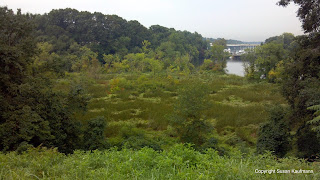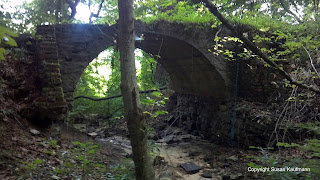Long-time readers might remember our story on Bonaparte's discovery of the female Cape May warbler. We'd originally found the site of his home, Point Breeze, on our visit to Bordentown last summer, though we didn't venture onto the property. Now the home of Divine Word Missionaries' East Coast facility, access to the acreage is restricted to residents and guests who've arranged permission in advance.
Enter noted birder and Hidden New Jersey friend Rick Wright, who invited us to scout out the property with him and his wife Alison. Believe it or not, fall migration is already underway, and what better place to bid warblers a bon voyage than the former home of a man who shaped birding history? Naturally, I was also intrigued by the property's connection to Napoleon's family and their European exile, so I didn't need to be asked twice. Rick had already gained permission from Divine Word; we were set to go.
The weather was overcast and humid on our arrival; we hoped we wouldn't be rained on, at least until we'd had a chance to explore a bit.
The Divine Word grounds are well-manicured, with broad expanses of grass around the few 1950s-era buildings and a driveway. There's only one building left from the 1800s -- a small stone house built for one of Joseph Bonaparte's advisors next to the area which once held a formal garden. Hearing very little in the way of birds, we decided to check out the trees at the perimeter of the property and explore from there.
 |
| The view from the Point Breeze property. |
"Maybe we should try channeling the spirit of Bonaparte," I suggested to the chuckles of my companions. Who knows? Perhaps he'd take pity on us and help some fellow birders find a productive patch on the property.
Hoping for more success in the woods, we found a barely-noticeable break in some nearby underbrush and headed in. Again, but for the constant whirring of the usual annual cicadas, we were hearing virtually nothing but the occasional mewing of random catbirds or a complaining blue jay.
While I was jazzed about birding in the footsteps of a great ornithologist, my real interest in the woods was the potential for finding evidence of Bonaparte's presence there. Much has been made in certain circles of a tunnel system extending from the family mansion's basement to the creekside, but I was interested in finding other structures. Would we find a brick-paved path or perhaps a well?
 |
| This arch probably supported a carriage path through the woods; it appears that a stream flowed beneath it. |
A look toward the creek exposed some possible aquatic life, but beyond the catbirds, nuthatches and a wren or two, we weren't hearing or seeing much else at all. The day may have been a bust birding-wise, but it was a great scouting expedition and a view into a truly hidden aspect of New Jersey history. Given more favorable conditions, it definitely would be a wonderful place to find a wide variety of songbirds in migration.
And while he apparently couldn't influence the migration, maybe Bonaparte helped us out, after all. Not two minutes after we got into the car to leave, raindrops started falling on the windshield, the start of what became a persistent storm.
No comments:
Post a Comment
Note: Only a member of this blog may post a comment.